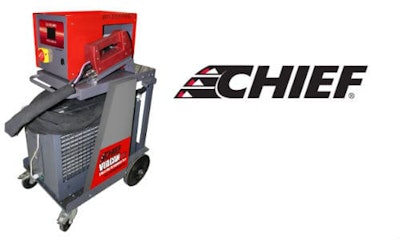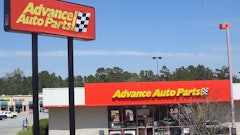
Madison, Indiana — April 12, 2016 — New materials require new joining methods, but those new methods may also find their way into steel construction as well. Structural adhesives are used extensively in vehicles designed with aluminum, but are also becoming increasingly popular with OEMs in the manufacture of traditional steel-based vehicles.
Repairing collision damage to areas built with structural adhesives can be challenging. The most effective method technicians currently have to separate bonded pieces of aluminum is to manually chisel them apart. This approach is not only physically tiring, but involves considerable risk of damage to the panel being removed, as well as the surface behind it. For panels made of carbon fibre, the only option is to grind through layers, releasing harmful carbon fibres if the dust is not properly captured. That’s where the new Chief Vulcan Adhesive Debonding Unit (ADU) comes in.
The patent-pending Chief Vulcan ADU is specifically designed to break the bond of structural adhesives in automotive applications. The Vulcan ADU uses infrared radiation technology to quickly heat the surface to a temperature where the first layer of glue underneath releases cleanly, in as little as 20 seconds. With the adhesive bonds broken, the technician can then separate the materials with less risk of damage to either piece. The epoxy remains smooth and hard, not sticky, leaving behind a clean work surface. The Vulcan ADU can be used on any vehicle surface, including aluminum, carbon fibre and steel.
Applying heat is a proven method for releasing adhesives, but although there are several options available for traditional steel panels, tight temperature control is needed to not overheat high-strength steels. Aluminum is more challenging because it dissipates heat very quickly and requires a lot of input energy: more than is found in traditional induction heaters or heat guns.
The Vulcan ADU uses very short waves of infrared radiation to quickly produce up to 600 degrees of heat concentrated at the surface of the material being treated. Even though the unit produces very high output temperature, the lamp’s handles and sides remain cool to the touch for safe operation and prolonged lamp life.
The Vulcan ADU has three modes of operation.
Manual: Pulling the trigger will produce whatever level of power the technician set until the trigger is released.
Automatic: The technician sets both a set point temperature and the power level, and the unit will control to that level while the trigger is pressed.
Programmable: The technician can set up to five steps including a specific temperature and how long the Vulcan should stay at that temperature.
To learn more about the Chief Vulcan Adhesive Debonding Unit, please visit chiefautomotive.com/Shop-Tools/Vulcan-ADU.























